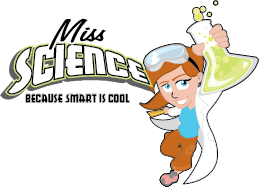I am SO excited to have kicked off my new website www.missscience.com this past month! I
have also been traveling quite a bit . I’ve been to FETC, TCEA, ASCD, TxLA and in and out
of schools in Florida sharing with teachers, librarians and administrators the importance of
creating Makerspaces that support STEM, Entrepreneurship and true Project-Based Learning. Let’s just say anyone who attended my sessions or presentations walked away with a semester full of ideas that were sparked by the use of a sewing machine! AND this week I will land right back where it all began. I’ll be on Arizona Midday (NBC-Phoenix) with Jan D’Atri!

No matter where I travel to I always seem to find the magic of Science in what I’m doing. Last weekend, I traveled to NOLA to study the Science of Jazz, Food and Festivals (more on that in my next blog). I love to visit antique stores and during my visit last weekend I came across a fantastic display of jewelry and items made from Bakelite. If you are unfamiliar with Bakelite it was the first synthetic resin, or what we might call the first modern plastic. While teaching the Science of Slime for over 10 years, I’ve created many experiments around bioplastic and of course 3D printers have made it possible to create almost anything using a synthetic plastic filament. So this got me thinking…. HOW has plastic changed throughout history? From rubber containers used by Meso American cultures to the water bottles that we use everyday the transition from natural resources that were used for thousands of years to the sudden evolution of synthetic substances seemingly goes unnoticed. Although plastics, as we have come to know them have only been around for 150 years the development of less expensive, disposable products made from plastics have changed our world in a short amount of time.
With need comes innovation and with innovation comes change. Until the 1950s
plastic was rarely used in products and for packaging that we see it in today. Milk
came in glass containers, meats were packaged in “butcher” paper, and students wrote
with graphite pencils. Many toys and games were also made from wood and rubber.
Today it is hard to find products that are NOT made from some type of plastic. The
invention of plastic has revolutionized technology. Try comprehending what your
computer keyboard or cellphone might look like without plastic.
There are many reasons for the evolution of plastic, including the transition from using scarce and natural resources such as ivory, to the ease of mass production. Plastics in their infancy were extremely hard and opaque, while today they can be thin, nimble, and clear. The mass production of plastic has made our lives easier; however, this also has created a need for Environmental Stewardship. I challenge you to take notice and think about how the products you use everyday were made. As we begin to realize what and how much we consume, it gives us a better perspective on how we can make a difference. Do you know the difference between a PLA (a plastic substitute made from corn) and PET (plastics used in most water bottles)? Is one better than the other? Are you aware that there are 7 types of plastic each with different recycling codes?
I guess what I’m trying to say is that the plastics we use today didn’t exist 150 years ago and to think about how that has changed our world is remarkable! SCIENCE made it happen, yet we are responsible to ensure that the science behind the plastic doesn’t create a planet of waste. Reduce, Reuse and Recycle my friends.
So I’ll be going old school during my Midday segment to share how you can use milk, vinegar and some heat to create a bioplastic. Although milk plastic doesn’t make for the most durable material, it is a fun experiment for learning about chemical reactions and more! I will also share ideas for Project-Based Learning that can bring in the study of game design (and the use for milk plastic game pieces) as well as reading biographies about great inventors like Milton Bradley and Social Emotional Learning through incorporating entrepreneurship. What could be better than designing your own game to sell!
Want to learn more? Click on Making Plastic From Milk to find resources, videos,
lesson plans and more that I curated with Collections by Destiny.
